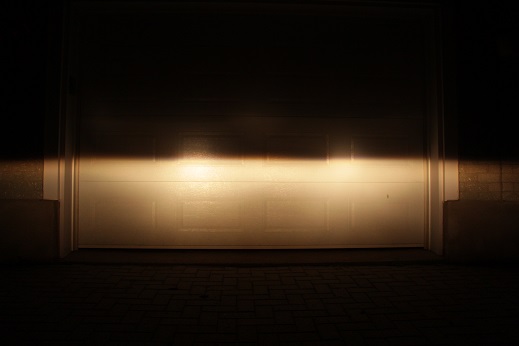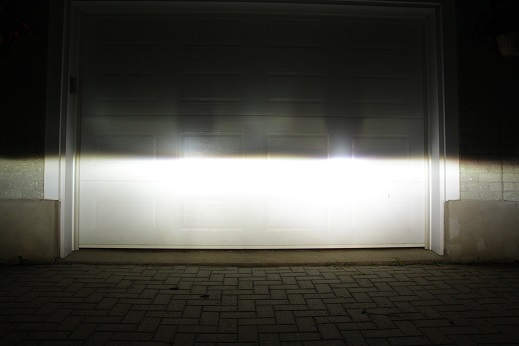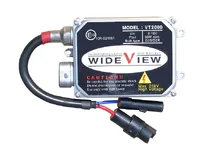Well, I finally got to install my Morimoto Kit from TRS on my non-tech Touring, so I thought I might share my thoughts on how they perform. The kit I got was the Morimoto Elite H11 with the 3Five DSP (35W) and the XB35 5000K (pure white) bulbs.
I do not have the tools to produce a scientific level comparison between HIDs and the OEM halogens so hopefully the pictures I gathered will suffice. All pictures below were taken with a Canon DSLR camera with the following parameters:
F number: 3.5
ISO: 800
White balance: 5200K
The white balance was chosen because it produced the best match to what my eyes could see.
Light pattern:
Here is a picture of the light pattern from the OEM halogens

And here is a picture of the light pattern for the HIDs

In order to compare the light pattern of the halogens to that of the the HIDs while removing the bias introduced by changes in intensity, I set up my camera to capture about the same quantity of light. In this case, the halogens picture was taken with an exposure of 1/125 s while the HID picture used 1/400 s.
For me, the light patterns are practically identical: the cutoff is exactly in the same spot and both bulb types exhibit bright spots in the same locations. The downward falloff from the hot spots might be slightly less pronounced for the HID bulbs. Normally this can be a problem, since it can cause an over bright foreground which can reek havoc on you night vision. In this case, the difference is so slight I doubt it will have any impact at all. Both bulb types also produce the same level of light uniformity.
As for light bleed above the cutoff, the two are also practically identical when considered proportionally to the bulb brightness. In fact, the return wire on the XB35 bulbs cast a vertical shadow above the cutoff because of their particular position (as opposed to on the ground with standard HID bulbs), reducing the glair even more than with halogen bulbs. This becomes more obvious in the pictures that follow below. In fact I strongly recommend getting the XB35 bulbs for that very reason, and because a return wire shadow on the ground would be distracting.
Brightness:
As mentioned above, I had to use an exposure nearly three times faster with the HIDs to get the equivalent brightness in the pictures. That means that the HIDs produce about 3 times as much light as the OEM H11 halogens. And man does it make a difference! Below are the same images as above, but with 1/100 s exposures for both images.
The halogens:

The HIDs

As you can see, the difference is almost literally night and day. On the other hand, with similar exposures you can see a bit more bleed above the cutoff for the HIDs. In the discussion about pattern, I said that bleed above cutoff was similar proportionally to bulb intensity. That means that with the increased HID intensity, you also get more bleed, even if the cutoff is just as sharp. To get an idea of how this might affect glair for oncoming traffic I placed my camera just above the cutoff and took this picture:

It might not be obvious on the picture, but just above the cutoff, the headlights produce no more light than the fog lights, which are designed to prevent glair (I find them more decorative than anything else). Note that my fog lights are equipped with 860 lumen 5000K H11 LED bulbs from VLEDs. This convinces me that glair should not be an issue with this HID kit in the OEM halogen projectors.
Color and warm-up time:
After turning these on for the first time, it took about 5 seconds for them to brighten up and reach a nice constant white color with no hint of yellow or blue, and even a nice purple fringe above the cutoff. I don't expect to be in any real driving condition prior to 5 seconds after turning on the car, so 5 seconds is really acceptable. To me, the 100 lumen hit between the 4300K and 5000K bulbs is well worth it in order to get this gorgeous white color, but this is obviously subjective. Most HID pictures shown here were taken in the first minutes after turning them on. The color might change slightly after a wear-in period, but I expect the effect to be minor. On initial turn on, these go trough a pink to blue hue before reaching pure white. Here comes my only minor annoyance: both bulbs do not go trough the pink-blue-white cycle at the same time, so it looks like you have a disco light show in front of your car. But then again, it only lasts 5 seconds and might disappear after the break-in period.
Conclusion:
I have only just driven down a few blocks with these, but I am already in love! I love the brightness, the color and the surprisingly good light pattern (especially after reading so many rants on plug-in HID kits on other forums). How do these compare to the OEM HIDs? I don't know since I don't have them. In any case, I think that this overall minor 150$ upgrade is worth every penny!
If there is sufficient interest, I might post the installation procedure in the How-to section...
I do not have the tools to produce a scientific level comparison between HIDs and the OEM halogens so hopefully the pictures I gathered will suffice. All pictures below were taken with a Canon DSLR camera with the following parameters:
F number: 3.5
ISO: 800
White balance: 5200K
The white balance was chosen because it produced the best match to what my eyes could see.
Light pattern:
Here is a picture of the light pattern from the OEM halogens

And here is a picture of the light pattern for the HIDs

In order to compare the light pattern of the halogens to that of the the HIDs while removing the bias introduced by changes in intensity, I set up my camera to capture about the same quantity of light. In this case, the halogens picture was taken with an exposure of 1/125 s while the HID picture used 1/400 s.
For me, the light patterns are practically identical: the cutoff is exactly in the same spot and both bulb types exhibit bright spots in the same locations. The downward falloff from the hot spots might be slightly less pronounced for the HID bulbs. Normally this can be a problem, since it can cause an over bright foreground which can reek havoc on you night vision. In this case, the difference is so slight I doubt it will have any impact at all. Both bulb types also produce the same level of light uniformity.
As for light bleed above the cutoff, the two are also practically identical when considered proportionally to the bulb brightness. In fact, the return wire on the XB35 bulbs cast a vertical shadow above the cutoff because of their particular position (as opposed to on the ground with standard HID bulbs), reducing the glair even more than with halogen bulbs. This becomes more obvious in the pictures that follow below. In fact I strongly recommend getting the XB35 bulbs for that very reason, and because a return wire shadow on the ground would be distracting.
Brightness:
As mentioned above, I had to use an exposure nearly three times faster with the HIDs to get the equivalent brightness in the pictures. That means that the HIDs produce about 3 times as much light as the OEM H11 halogens. And man does it make a difference! Below are the same images as above, but with 1/100 s exposures for both images.
The halogens:

The HIDs

As you can see, the difference is almost literally night and day. On the other hand, with similar exposures you can see a bit more bleed above the cutoff for the HIDs. In the discussion about pattern, I said that bleed above cutoff was similar proportionally to bulb intensity. That means that with the increased HID intensity, you also get more bleed, even if the cutoff is just as sharp. To get an idea of how this might affect glair for oncoming traffic I placed my camera just above the cutoff and took this picture:

It might not be obvious on the picture, but just above the cutoff, the headlights produce no more light than the fog lights, which are designed to prevent glair (I find them more decorative than anything else). Note that my fog lights are equipped with 860 lumen 5000K H11 LED bulbs from VLEDs. This convinces me that glair should not be an issue with this HID kit in the OEM halogen projectors.
Color and warm-up time:
After turning these on for the first time, it took about 5 seconds for them to brighten up and reach a nice constant white color with no hint of yellow or blue, and even a nice purple fringe above the cutoff. I don't expect to be in any real driving condition prior to 5 seconds after turning on the car, so 5 seconds is really acceptable. To me, the 100 lumen hit between the 4300K and 5000K bulbs is well worth it in order to get this gorgeous white color, but this is obviously subjective. Most HID pictures shown here were taken in the first minutes after turning them on. The color might change slightly after a wear-in period, but I expect the effect to be minor. On initial turn on, these go trough a pink to blue hue before reaching pure white. Here comes my only minor annoyance: both bulbs do not go trough the pink-blue-white cycle at the same time, so it looks like you have a disco light show in front of your car. But then again, it only lasts 5 seconds and might disappear after the break-in period.
Conclusion:
I have only just driven down a few blocks with these, but I am already in love! I love the brightness, the color and the surprisingly good light pattern (especially after reading so many rants on plug-in HID kits on other forums). How do these compare to the OEM HIDs? I don't know since I don't have them. In any case, I think that this overall minor 150$ upgrade is worth every penny!
If there is sufficient interest, I might post the installation procedure in the How-to section...
Last edited:



